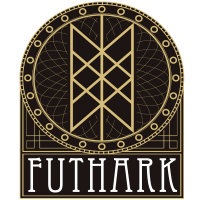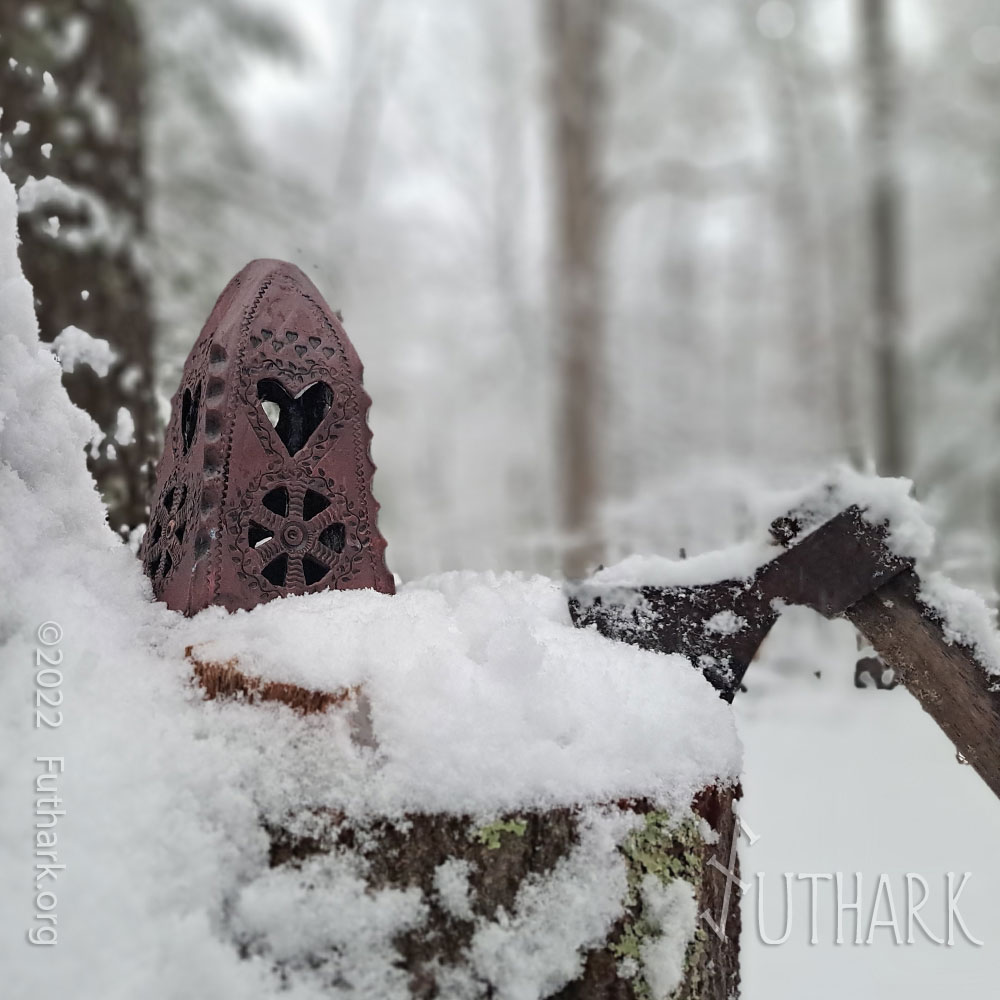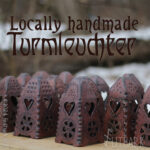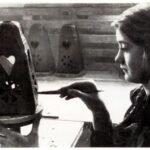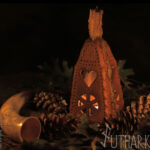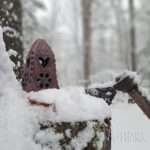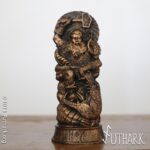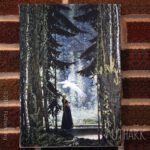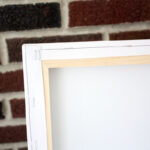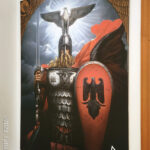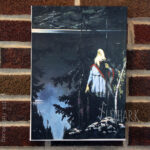The Yule Leuchter (Julleuchter) or “Yule Lantern” is a terra cotta candlestick approximately 8″ tall and approximately 4″ at the base. These handmade earthenware family heirlooms are sometimes referred to as Turmleuchter. The Irminfolk is proud to offer these individually hand-sculpted ritual items for your family hearth and traditions. Our Turmleuchter are locally hand made and each one is uniquely decorated. You will get a randomly selected lantern.
Design and origin:
The design of the Julleuchter was based on an early modern (late 18th century or early 19th century) unburnt clay candle-holder from Hedeby, Sweden. This particular specimen is kept in the Nordic Museum in Stockholm (inv. nr. 32.477). First described in 1888 in the magazine of the Swedish literary club ‘Runa’, This artifact was attributed to 16th century Scandinavian origin (coinciding with the earliest known use of candles in Scandinavian homes), but the tradition of the Tower Lantern is attributed to Frisian origins.
On each of the four sides is a cutout Heart, representing the Hearth and Home, and below these hearts is a Hagal Rune, representing Orlog, or uncontrollable progress.
The Yule leuchter is used as a memento of the “Year of the Great Migrations” of the people of the north and as the small light of humanity under the stars of the night sky. When used during the 2 Solstice periods of the year, this is a symbol of the victory of Light over the Darkness, and also as a token of Eternal Circulation. The Julleuchter stands for an inseparable community, its conscience and attitude, and that it was used as a symbol of never ending sunlight.
Our Yule Leuchters are individually hand sculpted by a local potter, as these are hand made, there are slight variations in each one. The photos are general representations what they look like.
How the Yule Leuchter is used:
During the Vernal Equinox, the holiday of Ostary (Ostara) which symbolizes the revival of the sun, a candle is lit in the lower part of the Julleuchter and is then transferred to the upper position.
During the Summer Solstice (Mittsommer-Feier) the holiday that symbolizes the sun, which entered the total force. A candle only burns at the top of the Julleuchter.
During the Autumnal Equinox or Autumnal Ting (Herbst-Thing), A candle is lit at the top of the Julleuchter and transferred downward.
When the Julleuchter was used during the holiday of Yule (what is now known as The 12 Days of Christmas), twelve candles are used. One tealight candle is burned below (inside) each night symbolizing the twelve months, until the 31 of December when the “July Moon shines.” On that night a thirteenth candle is used for the new coming month of January. The candles always burn below but on the last night, the candle is again transferred upward- this is the sun, which is spilled in order to return to the earth from the gloom.
“We will start by stating that the year is divided into six equal spokes. For simplicity’s sake, we will call the first spoke the Ostara-fest, since this commences the “light half” of the year. Prior to the Blot itself, the Jul-leuchter is set with a candle at the Summit, as well as one underneath. At the beginning of the blot, we light the candle underneath by using a twig, which receives its flame from the stove – symbolic of the old Hearth Fire as the stove holds the family’s cooking fire. At the high point of the Blot, it becomes time to take the flame from the candle underneath and take it to the top candle. This sacred act is symbolic of the re-birth of the Sun, since we are now in the “light half” of the year (meaning that the Sun is commencing her ascent). For the next two festivals, the Midsummer-fest and the Harvest-fest, only a Summit candle is lit, as we are still in the “light half” of the year. The Winternights-fest is quite the opposite of the Ostara-fest. The Jul-leuchter is set with the candle underneath, and one on the Summit. As we are entering into the “dark half” of the year, we begin by lighting the Summit candle (from a flame taken from the stove). From this, we transfer the flame to the bottom candle. This symbolizes the death of the Sun – as she is in the decline, moving toward her “grave”. The Jul-fest is quite a special festival, and the use of the Jul-leuchter is a little different than the other festivals… The Winter Solstice is a time when the Sun is at her lowest, seemingly dead. So our late evening Jul-fest rite (held on the 21st December) uses the Jul-leuchter to help “re-awaken” her from her grave. As it is the “dark half” of the year because the hours of daylight are so short – we begin our rite by lighting the candle underneath the Jul-leuchter. This candle is the same candle we used at the past year’s Jul-fest, which sat on the Summit. We then take a small twig, and pass this through the heart or Hagal-rune on the North side of the Jul-leuchter. The purpose of this is to take the flame from the bottom candle, and transfer it to the top candle. This symbolizes the eternal return of the Sun. After this time, all go to bed and in the morning, all awaken and look to see if the Sun has arisen from her grave – if it is so, all say a prayer of greeting to her, and open gifts in her honor, and in the honor of our Gods and Goddesses, who have made it possible. Finally, we have the Disting-fest. This is another “dark half” festival, so only the candle underneath is lit.” – Khaynrikh Shil’d in “Светильник Йоля”
Safety:
Never leave a burning candle unattended
Burn candle out of the reach of children and pets
Do not burn candles on or near anything that can catch fire
We recommend setting the Yule leuchter on top of a non-combustible pan or saucer as a precautionary “dam” when using a candle in the “below” position. The reflected heat within the lamp may melt the wax, forming a pool which could potentially ignite.
